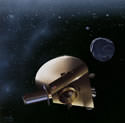
Image credit: SWRI
Although the Kuiper Belt, a region of icy objects located past the orbit of Neptune, was only discovered in 1992, it’s already presented a host of mysteries. One mystery is why an unusually large number of these objects have small satellites orbiting them – 8 out of the 500 objects discovered so far have had satellites. The high number brings into question the traditional theory that they’re caused by collisions.
The Kuiper Belt region of the solar system, which stretches from just past Neptune to beyond the farthest reaches of Pluto?s orbit, was only discovered in 1992, but continues to reveal new knowledge into the formation processes of the planets. Now, in a paper to be published in the October issue of The Astronomical Journal, a Southwest Research Institute? (SwRI?) scientist reveals a new mystery about Kuiper Belt Objects (KBOs).
The study examined the formation of KBO satellites, which have been observed only since 2001 and continue to be discovered around an unexpectedly large number of the more than 500 known KBOs.
?In just over a year since the first satellite of a KBO was found, scientists have discovered a total of seven KBO satellites. Surprisingly, observations by both ground-based telescopes and the Hubble Space Telescope have indicated that, in many cases, the KBO satellites are as large or nearly as large as the KBOs around which they orbit,? says Dr. S. Alan Stern, director of the SwRI Space Studies Department. ?That so many binary or quasi-binary KBOs exist came as a real surprise to the research community.?
The focus of Stern?s work was not observational in nature, but rather it sought to understand how such large KBO-satellite pairs could form. The standard model for large satellite formation is based on collisions between an interloping body and the parent object around which the satellite orbits. This model has successfully explained binary systems around asteroids and the Pluto-Charon system, and also has direct relevance to the formation of the Earth-moon system.
Stern?s findings call into question the formation of KBO satellites by standard collisional processes. Collisions of the magnitude required, Stern found, appear to be energetically improbable, given the number and masses of potential impactors in both the ancient (more massive) and modern day (eroded) Kuiper Belts.
This likely implies one of two alternatives: Either KBO satellites were not formed by collisions, as has been commonly assumed, or the surface reflectivities (which help determine size) of KBOs with satellites, or the reflectivity of the satellites themselves, have been significantly underestimated.
?If the surfaces of KBOs with satellites, or the satellites themselves, are more reflective than previously thought,? says Stern, ?these objects would be smaller and less massive, and would therefore require smaller, less energetic impacts to create the satellite systems we see.?
NASA?s new Space Infrared Telescope Facility (SIRTF), set for launch early next year, will help resolve these two alternatives, Stern says, by directly measuring the reflectivities and sizes of numerous KBOs, including those with satellites.
In addition to this work, Stern serves as principal investigator of the NASA New Horizons mission to Pluto and the Kuiper Belt. Expected to launch in January 2006, this spacecraft will make the first ever flyby reconnaissance of the Pluto and Charon system and then go on to explore KBOs as it leaves the solar system. New Horizons is the only NASA mission planned to study Kuiper Belt Objects at close range.
The NASA Origins of Solar Systems program provided funding for this research.
Original Source: SWRI News Release

For space research telescope is necessary but we can not get fruitful result without study of space mirror. From the ancestral time the world space research established on blind theory. We although demand that we have discovered lots of mysteries viz. milk ways, galaxies, nebulas, white drafts, black holes etc., in real they are creation of space mirror. SPACE MIRROR is the truth and hidden mystery of the space. Since we are unknown about space mirror, our research has diverted from original truth and we have spent lots of time and money behind the false truth.
Therefore it invites to visit http://www.spacemirrormystery.com and for prosperous space research.